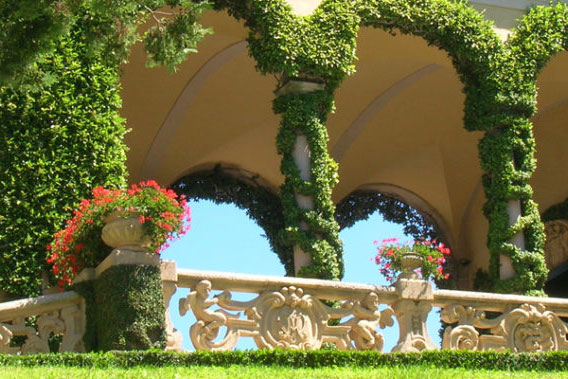
Protected by the alps to the north, the Italian Lakes District has high rainfall in both the summer and winter months, this combined with the large expanses of water, creates perfect growing conditions for many varieties of plants. The gardens in this area are some of the most lush in all of Italy.
Your itinerary will take you first to Isola Bella in Lake Maggiore where you will see visit one of the most dramatic Italian Baroque Villas of the 17th century. The entire surface of the island is covered in 10 perfectly maintained garden terraces reaching right down to the waters edge. Here you will see every kind of garden element imaginable from the grottoes to the water theater to the classical parterres. Next, you will visit Isola Madre where semi-tropical plantings thrive and white peacocks run free. It is a virtual floating botanic garden. Here agaves and bouganvilleas flourish alongside azaleas, camelias and rhododendrons. Then on to a more modern but no less fascinating garden. This property on Lake Maggiore was bought in the mid 1800’s by an Irish family whose descendants from 1910 until 1916 employed thirty gardeners to create the beautiful terraced gardens we see today. Here we have the Garden of Hours, the Garden of Joy, the Garden of Sadness, the Garden of Memories and the Garden of Sighs. Next you will visit an 18 hectare botanic garden which was created by a Scotsman to showcase the wide variety of semi tropical and exotic plants which the lake’s micro-climate makes it possible to cultivate. Then on to Lake Como where you will visit a Villa with steps and terraces which descend towards the lake. A romantic landscape garden was made by the Dukes of Sachsen Meiningen in the nineteenth century and it has become a botanic garden with rhododendrons, azaleas, magnolias and tree ferns. Finally you will discover a villa in the neoclassical style, which is surrounded by a splendid park which was the first example of an English-style garden in the Como area. Even the distribution of the vegetation, which seems absolutely natural, is the fruit of long and careful studies aimed at increasing the optical illusion in terms of backgrounds and distances.

